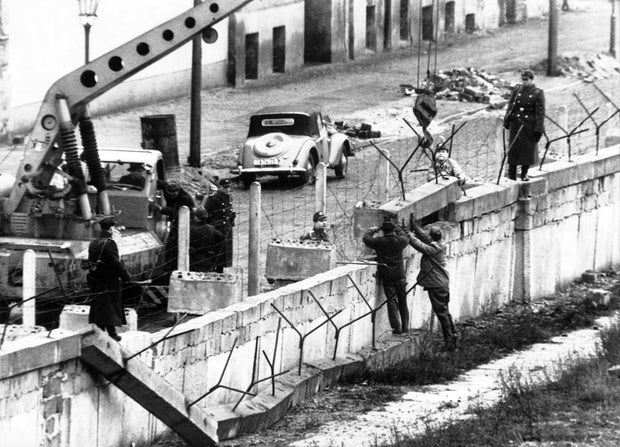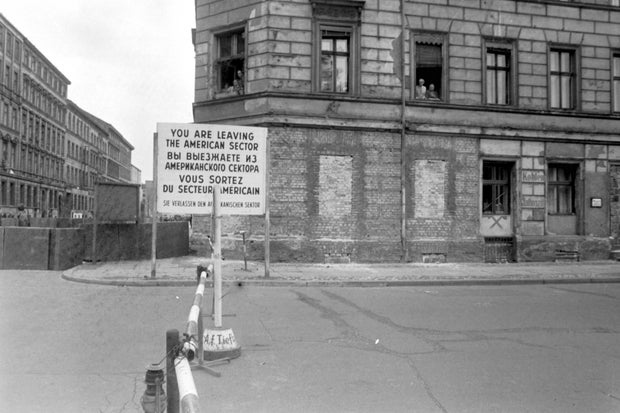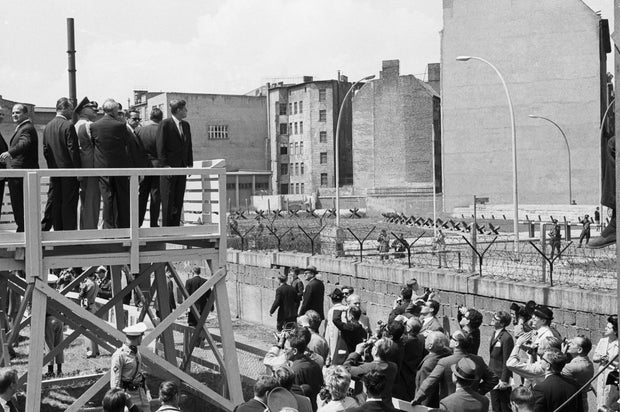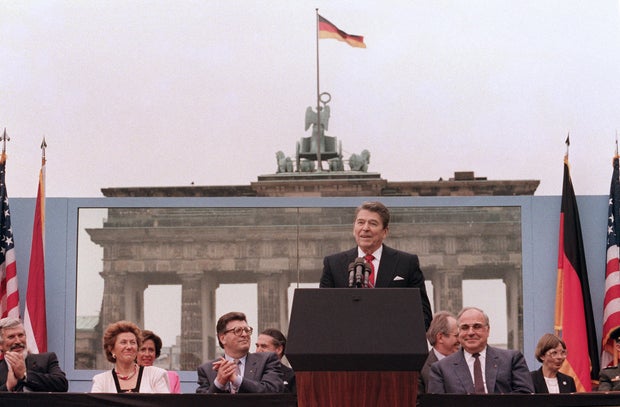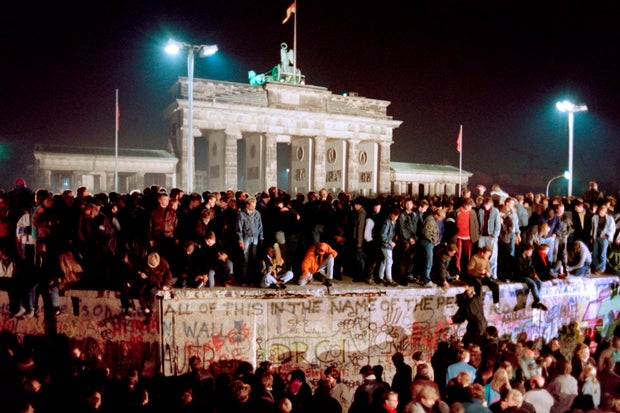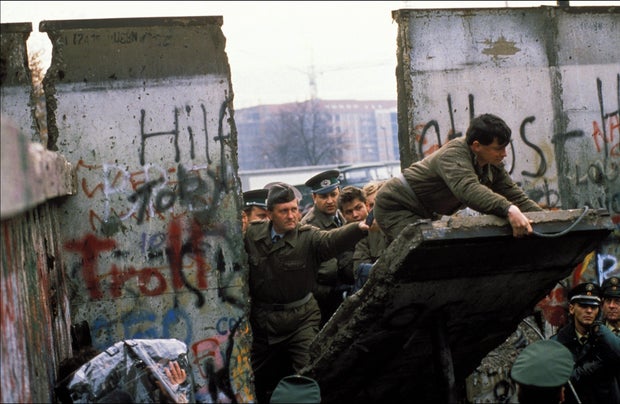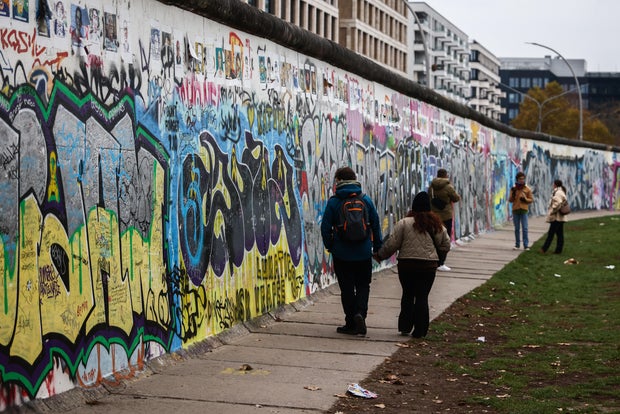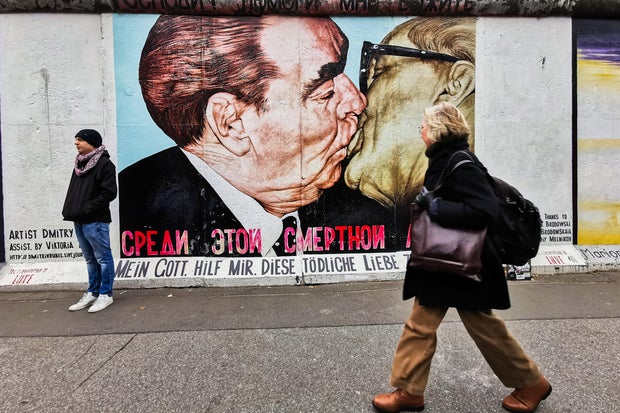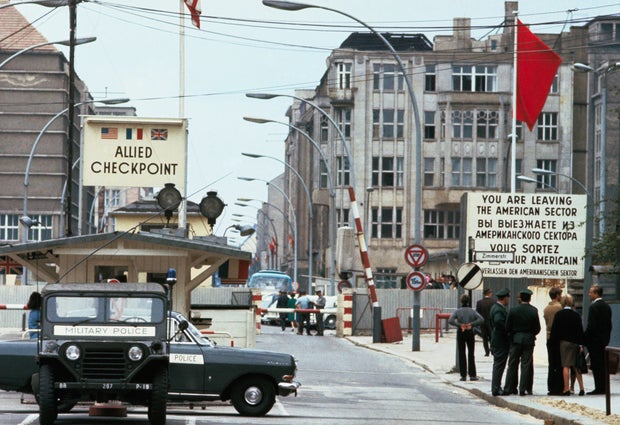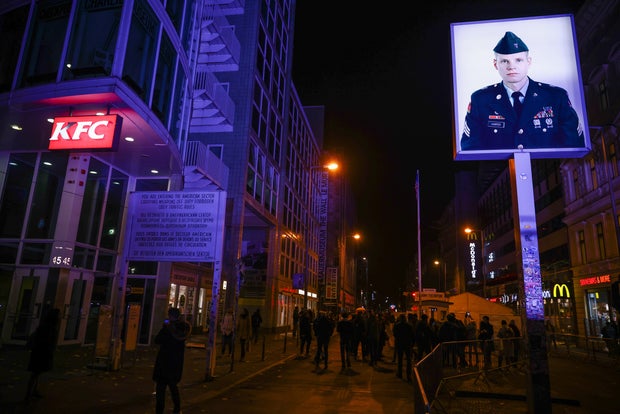CBS News
The Berlin Wall came down 35 years ago today. Fragments of the famous border still remain today.

Communist East Germany closed its border in Berlin on Aug. 13, 1961, when it erected a wall that eventually turned into an increasingly elaborate fortification snaking through the city and around capitalist West Berlin.
The heavily fortified border —the Berlin Wall— plugged the last gap between East and West.
On Nov. 9, 1989, the border was opened, and the Berlin Wall ceremoniously came down as the world watched. It marked the beginning of the end of the Cold War and the fall of the Communist dictatorship in East Germany, paving the way for German reunification in 1990 and the collapse of the Soviet Union in 1991.
Most of the wall was torn down quickly after, but 35 years later, there are still places where visitors can see its remains.
What was the Berlin Wall?
The Berlin Wall was built in 1961 and for 28 years, it stood as the front line of the Cold War between the Western world order, led by the U.S., and the Soviets.
East Germany’s leadership had already sealed off the country’s main border with West Germany, which snaked from the Baltic Sea to Czechoslovakia, in 1952.
Keystone-France/Gamma-Keystone via Getty Images
The 96-mile-long wall was built by the communist regime to cut off East Germany from the supposed ideological contamination of the West and to stem the tide of people fleeing Germany. It cut through the middle of the city center and surrounded West Berlin.
Alex Waidmann/ullstein bild via Getty Images
But not even barbed wire and the Wall could stop people from fleeing. The efforts to perfect the border fortifications in Berlin continued until 1989.
President John F. Kennedy’s pledge for freedom
President John F. Kennedy toured West Germany on June 26, 1963. During a speech to a crowd of about 150,000 people in West Berlin, he pledged that the United States would defend the city’s freedom.
“Freedom is indivisible, and when one man is enslaved, all are not free,” he said. “When all are free, then we can look forward to that day when this city will be joined as one, and this country and this great continent of Europe in a peaceful and hopeful globe.”
Bettmann
“When that day finally comes, as it will, the people of West Berlin can take sober satisfaction in the fact that they were in the front lines for almost two decades,” Kennedy added.
Then he closed with his now iconic phrase: “All free men, wherever they may live, are citizens of Berlin, and, therefore, as a free man, I take pride in the words, Ich bin ein Berliner.”
“Tear down this wall!”
President Ronald Reagan, commemorating the 750th anniversary of Berlin, spoke at the base of the Brandenburg Gate, near the Berlin Wall, on June 12, 1987. Due to the amplification system being used, Reagan’s words could be heard in East Berlin.
MIKE SARGENT/AFP via Getty Images
During his address, the American president made the now famous command, “Tear down this wall!,” addressing the Soviet leader Mikhail Gorbachev.
Reagan’s speech on that day is considered by many to have ushered the beginning of the end of the Cold War, which culminated with the fall of the Soviet Union.
When did the Berlin Wall fall?
In the late 1980s, the power of the Soviet Union began to waver, particularly when Gorbachev became General Secretary of the Communist Party in 1985. He abandoned the Brezhnev Doctrine, a central political principle of Soviet foreign policy that demanded limited sovereignty of the Warsaw Pact nations.
This allowed the Eastern Bloc of states to shift their own foreign policies, and on May 2, 1989, Hungary dismantled its border fence – making the first hole in the “Iron Curtain.”
GERARD MALIE/AFP via Getty Images
In East Germany, a growing protest movement and a migration wave to the West forced the dictatorship there to end in 1989. A new travel law mistakenly announced on Nov. 9, 1989, led to an onslaught of people to rush the Berlin Wall.
How did the Berlin Wall fall?
The Bornholmer Strasse crossing in Berlin was the first to open that night. Border guards, who hadn’t received orders to let anyone pass, gave way under pressure from a large crowd demanding to be let through after an off-handed announcement of new regulations by Politburo spokesperson Günter Schabowski.
Patrick PIEL/Gamma-Rapho via Getty Images
New border crossings were created, leaving behind large gaps in the Wall. Border soldiers began dismantling fences and other obstacles.
In June 1990, the systematic dismantling of the Wall began, and pieces of the concrete were sold all over the world. Some sections were placed under protection as historical monuments.
robert wallis/Corbis via Getty Images
The fall of the Berlin Wall paved the way for the unification of Germany on Oct. 3, 1990, less than a year after the border reopened. The demolition of the Wall ended in 1994.
Where can you see sections of the Wall today?
Today, there is a section of Wall slabs with photos and a series of plaques – including an alert sent by the Associated Press’ Germany service – that stands at the former Bornholmer Strasse crossing in Berlin.
Beata Zawrzel/NurPhoto via Getty Images
The longest section of Wall remaining in Berlin is in the so-called East Side Gallery, where the once-gray concrete slabs are covered with murals that were painted by 118 artists after the opening of the border.
Otherwise, the Wall has largely disappeared now and much of the former “death strip” — between the exterior wall that faced West Berlin and an interior wall that faced the East — has been built over.
Beata Zawrzel/NurPhoto via Getty Images
Among the exceptions is a strip of the former border at the Bernauer Strasse memorial site in downtown Berlin, and there are fragments dotted around elsewhere in the city and on its edges.
In most cases, the main East-West German border outside Berlin consisted of heavily fortified fences rather than walls. There were a few exceptions, however: most famously in the village of Moedlareuth, divided between Bavaria and the eastern region of Thuringia, which earned the nickname “Little Berlin.” Part of Moedlareuth’s border can still be seen today.
What is Checkpoint Charlie?
One of the most famous – and most visited crossings commemorating the Wall in Berlin – is Checkpoint Charlie.
Bettmann
The historic U.S.-controlled border crossing between the East and West stood for three decades. There, Allied guards registered members of the American, British and French forces before trips to East Berlin, and foreign tourists could find out about their stay there.
In October 1961, it famously became the scene of a tank confrontation between Americans and Soviet forces who took up position and faced each other with weapons primed.
Beata Zawrzel/NurPhoto via Getty Images
The checkpoint booth was removed on June 22, 1990, about half a year after the wall opened. The original booth is now on display in the Allied Museum in Berlin-Zehlendorf. A photo of former U.S. Army tuba player Seargent Jeff Harper is part of series of photographs hanging nearby the original location commemorating the last Allied soldiers in Berlin in 1994.
CBS News
Man kills self in explosions outside Brazil’s Supreme Court
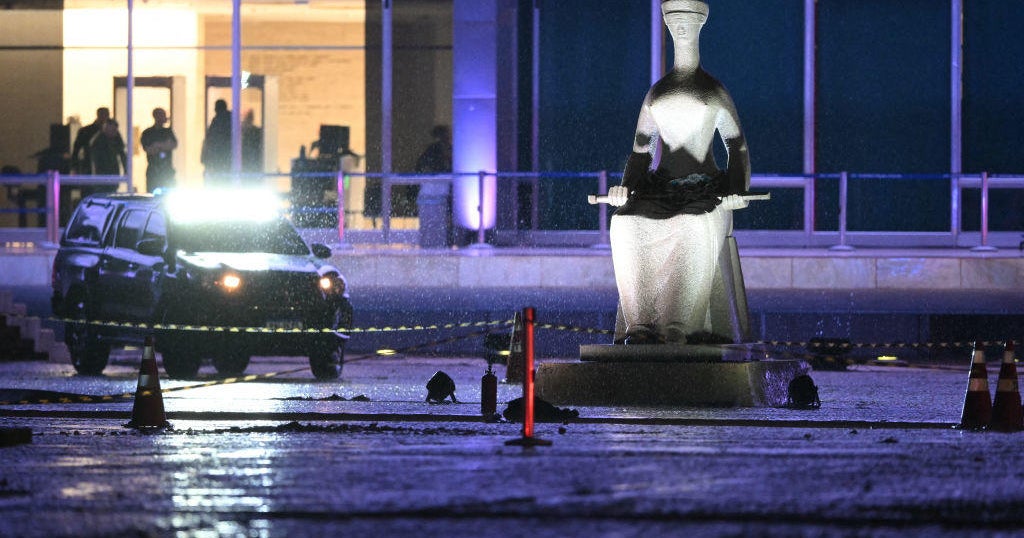
A man who failed in an attempt to break into Brazil’s Supreme Court killed himself in explosions outside the building Wednesday that forced justices and staff to evacuate, authorities said.
The two strong blasts were heard about 7:30 p.m. after the day’s session finished and all the justices and staff left the building safely, Brazil’s Supreme Court said in a statement.
Local firefighters confirmed one man died at the scene in the capital Brasilia, but did not identify him.
EVARISTO SA/AFP via Getty Images
Celina Leão, the lieutenant governor of Brazil’s federal district, said the suspect had earlier detonated explosives in a car in a Congress parking lot, which did not cause injuries.
“His first action was to explode the car. Then he approached the Supreme Court and tried to get in the building. He failed and then there were the other explosions,” Leão said in a news conference.
Local media reported that the car that exploded belonged to a member of Brazil’s Liberal Party, the same of former President Jair Bolsonaro. Leão said only investigations will determine whether the owner of the car is the same man who died in the blasts.
Leão recommended that Congress be closed Thursday to avoid new risks. Brazil’s Senate heeded her call and the lower house will be shut until noon, speaker Arthur Lira said.
“It could have been a lone wolf, like others we’ve seen around the world,” Leão said in a news conference. “We are considering it as a suicide because there was only one victim. But investigations will show if that was indeed the case.”
Leão added only forensics will be able to identify the body, which remained outside the Supreme Court for three hours after the blasts.
The blasts outside the Supreme Court took place about 20 seconds apart in Brasilia’s Three Powers Plaza, where Brazil’s main government buildings, including the Supreme Court, Congress and presidential palace, are located.
President Luiz Inácio Lula da Silva was not in the neighboring presidential palace at the time, spokesman José Chrispiniano said.
Police blocked all access to the area and the presidential security bureau was conducting a sweep of the grounds around the presidential palace.
Brazil’s federal police said it is investigating and did not provide a motive.
The Supreme Court in recent years has become a target for threats by far-right groups and supporters of Bolsonaro’s due to its crackdown on the spread of false information. In particular, Justice Alexandre de Moraes has been a focus for their ire.
Lula’s spokesman said that late on Wednesday the leftist leader was gathering at the presidential residence with federal police chief Andrei Rodrigues, and Supreme Court Justices de Moraes and Cristiano Zanin.
CBS News
11/13: CBS Evening News – CBS News

Watch CBS News
Be the first to know
Get browser notifications for breaking news, live events, and exclusive reporting.
CBS News
What to know about Trump’s Department of Government Efficiency, led by Elon Musk and Vivek Ramaswamy

Donald Trump is vowing to reduce wasteful federal spending by tapping two billionaires — Tesla CEO Elon Musk and entrepreneur Vivek Ramaswamy — to spearhead the initiative, which the president-elect is calling the Department of Government Efficiency, or DOGE.
The appointments, announced by Trump on Tuesday, raise a host of questions about the effort, including whether Musk and Ramaswamy will have the authority to make changes in federal outlays, given that Congress authorizes the nation’s spending, as well as where the businessmen might look to cut spending. Under the plan, meanwhile, DOGE is not an official government department, raising questions about how its powers and how it will operate.
The announcement comes a week after Trump won a second term as president, with voters expressing their dissatisfaction with the economy under the Biden administration. As part of his campaign vows, Trump promised to slash government spending. Musk’s bio on X, the social media platform he bought in 2022, now reads, “The people voted for major government reform.”
“Frankly, it does need to be done again, so every few decades you really need to look at everything,” Elaine Kamarck, a senior fellow in governance studies at the Brookings Institution who managed the Clinton Administration’s National Performance Review, an effort to cut government spending in the 1990s, told CBS MoneyWatch.
But Kamarck also harbors reservations about Musk and Ramaswamy’s mandate, especially after the former recently suggested he could find more than $2 trillion in savings — almost one-third of the federal government’s $6.7 trillion in annual spending. Two-thirds of that spending is mandatory through programs including Social Security and Medicare, while discretionary spending is largely spent on defense.
“This is the first warning sign that this is going to be a failed operation,” Kamarck said. “That’s insane.”
The Trump campaign didn’t immediately respond to a request for comment.
Here’s what to know about the Department of Government Efficiency.
What is the Department of Government Efficiency?
Trump announced the DOGE in a statement on Tuesday, describing it as an effort to “slash excess regulations, cut wasteful expenditures, and restructure Federal Agencies.”
The name is a nod to Musk’s support for a cryptocurrency called dogecoin, which was created as a joke by two software engineers and uses the image of a smiling Shiba Inu dog. (Dogecoin has more than tripled in price during the last month, and now trades at 38 cents.)
Trump said Musk and Ramaswamy’s work “will conclude no later than July 4, 2026,” or by the 250th anniversary of the Declaration of Independence.
Trump only outlined the initiative’s contours and didn’t disclose how it will be staffed or funded. The Trump campaign didn’t respond to a request about the DOGE’s funding or whether Musk or Ramaswamy will be paid for their work on the effort.
Can the DOGE actually cut federal spending?
At the moment, that appears unlikely given that the DOGE isn’t a real government department, which would need to be created by congressional approval. Federal spending is authorized by Congress, and senators and House representatives may hesitate to support cuts to major programs like Social Security or Medicare, which are popular with millions of voters, or to the nation’s military.
It’s also not clear how the organization will operate. It could come under the Federal Advisory Committee Act, which dictates how external groups that advise the government must operate and be accountable to the public.
Trump described Musk and Ramaswamy’s role as providing “advice and guidance from outside of government.”
That doesn’t amount to much, Kamarck said.
“They have no authority — none whatsoever,” she added, while noting that the backing of the president can help convince lawmakers to throw their support behind efficiency efforts.
What have Musk and Ramaswamy said about federal spending?
Musk, the world’s richest person with a net worth of $319 billion, according to the Bloomberg Billionaires Index, has described the U.S. government as bloated and said it its spending is unsustainable. The Tesla founder also said he wants to reduce the number of federal agencies to 99, down from more than 400.
“There are so many [agencies] that people have never heard of, and that have overlapping areas of responsibilities,” Musk said earlier this month.
While on the campaign trail with Trump, Musk also said he could cut “at least $2 trillion” from the annual budget. “Your money is being wasted, and the Department of Government Efficiency will fix that,” Musk said.
Musk is known for cost-cutting at his own companies, slashing most of X’s workforce after he bought the business two years ago as well as focusing on manufacturing costs at Tesla. Even so, those efforts have had mixed results, with X’s valuation falling by about 80% since his purchase. Tesla’s stock price, meanwhile, has surged 48% in the past year, bumping its value above $1 trillion.
Ramaswamy, whom Forbes says has a net worth of about $1 billion, dropped out of the presidential race in January after running on an “anti-woke” campaign. He also advocated for government cuts by eliminating the Department of Education, a goal shared by President-elect Trump.
Have administrations previously tried to cut costs?
Yes, both Republican and Democratic presidents have created efforts to cut government spending.
In 1982, President Ronald Reagan created the Grace Commission, led by wealthy businessman J. Peter Grace, the CEO of W. R. Grace & Company, a chemicals business. About 150 business people volunteered for the commission, which ultimately recommended 2,500 reforms, according to the Ronald Reagan Presidential Library.
“Most of the recommendations, especially those requiring legislation from Congress, were never implemented,” the library notes. “However, the Commission’s work provided a starting point for many conservative critiques of the federal government.”
In the 1990s, President Bill Clinton created the National Performance Review with the goal to create a government that would work better and cost less, Kamarck said. The group was staffed with civil servants who understood the bureaucracy, and many of whom had frustrations with it, she added.
The group had some successes in streamlining operations and paring costs, eventually cutting more than 300,000 jobs, according to a study from the Congressional Research Service. Kamarck noted that the group also focused on integrating technology into departments at a time when the internet was just emerging, leading to efficiencies such as online tax filing.
Where could the Trump administration cut spending?
While experts are skeptical of Musk’s claim he can cut $2 trillion in spending, they also point out there are opportunities to look at efficiencies.
Eliminating Medicare fraud is one area that could result in savings, according to the Citizens Against Government Waste, a nonpartisan group that looks at government spending. Its recommendations also include reducing the nation’s contributions to the U.N. and ending subsidies for some agricultural products, like dairy and sugar. Its projected savings: $377 billion in the first year, or about 19% of the $2 trillion that Musk is eyeballing.
But efficiency goes beyond cost-cutting, Kamarck noted. It’s also about understanding how the bureaucracy works,
“Every single thing in the federal government is big and complicated, and there are layers and layers of complexity,” she noted. “Al Gore and I relied on hundreds of experienced civil servants to tell us how this worked — and if you don’t do this, which I suspect they won’t because Musk is an arrogant billionaire, you will fail.”
Does Musk have conflicts of interest?
Yes, as Musk’s SpaceX works with the Department of Defense and NASA, with the federal government pledging $3 billion to his companies last year, according to the New York Times. Tesla, meanwhile, has been investigated by the National Highway Traffic Safety Administration, as well as by other agencies.
Federal employees are generally required to disclose their financial assets and entanglements to ward off any potential conflicts of interest, and to divest significant holdings relating to their work. Because Musk and Ramaswamy would not be formal federal workers, they would not face those requirements or ethical limitations.
contributed to this report.


